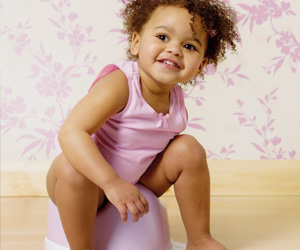When your little one seems very at home in a nappy, potty-training may seem like an impossible undertaking. But it needn’t be. Ciska Thurman asks an expert to help out
 Good to go
Good to go
Angela Attwood-Smith, play therapist and owner of Carrot & Cabbage playschool in Joburg, works with toddlers who are learning urinary independence. Girls and boys are definitely different, says Angela, but irrespective of gender, potty-training should only start once your child shows an interest in any of the following:
• The toilet or potty (sitting on it, even when fully clothed)
• Underwear (trying it on, even over a nappy)
• Their nappy (telling you about a wee or poo, asking for a change).
These early voluntary displays of toileting awareness are very developmentally significant – it means your little one is good to go! ‘Generally, boys potty-train between two-and-a-half and three years old, while girls tend to potty-train at two years or just after,’ explains Angela. What is important here, whether your little trainees conform to this trend or not, is that you let them initiate the process, and not rush them or impose your own agenda.
Getting the job done…
Take it step by step Start by initiating nappy-free afternoons: after your little one’s midday nap, encourage nappy-off, underwear-on time (this would be the ideal point to invest in some Dora the Explorer or Spider-Man undies). Then, advises Angela, follow this formula for the next few hours: Take your toddler to the toilet every 20 to 30 minutes, even if they say they don’t need to go. Praise any result, big or small.
Relax! Your own attitude is everything. Accidents will happen, so have handy whatever you’ll need to clean up and reassure them that you are proud of them for trying (and not angry about the mess).
Initiate a rewards system Whether it’s a progress chart or bean jar, reward your child for every step taken – such as agreeing to go, agreeing to sit, a tinkle or a plop.
Baby steps Encourage boys to sit when starting out (expecting to aim straight and wee simultaneously is seriously ambitious) and encourage girls to wipe from front to back from the start.
[Top tip] Once your afternoons are nappy-free, attempt having some nappy-free mornings as well, and don’t feel discouraged if the going seems slow. All children toilet-train according to different timelines – dependent on their gender, place in the family, temperament and how old they are.
Consider training pants
Many parents today are trying out training pants as a new potty-training aid. They’re designed to absorb one toddler-sized wee or poo, but unlike nappies, still make your toddler’s bum feel wet. This discomfort helps them identify the need to go. They are washable and reusable and can be pulled up or down like underwear.
Make it fun
• Dye the toilet water with food colouring and watch your little one’s reaction when their ‘efforts’ change the colour.
• Sing potty songs, read potty books and dance a potty jig when the job is done!
• Download a training app that sounds at intervals you determine. Personalise the sound, and soon your tots will be tootling off to the toilet on their own.
Potty problems
Toilet-training can derail and become counterproductive. Make sure you can recognise when to take a break or seek professional advice. Here are some common warning signs of a setback, says Angela:
1 Your child never makes it to the toilet in time.
2 Accidents either go totally unnoticed by your child or are extremely upsetting to him or her.
3 Nappy-free time makes your otherwise content child very anxious.
Remember that your toddler needs to learn muscle control to allow them to hold the bladder and rectum closed, something they had no voluntary control over up until now. So starting training too soon is a waste of your time, and a threat to your little one’s sense of security and self-esteem.
In rare cases, child counsellors or play therapists can assist in situations where poor toileting practice becomes harmful to the child and family (chronic constipation, the intense fear of ‘going’ in public places, for example). Often, there is an underlying problem that has nothing to do with toileting, but may be about emotional immaturity, sensory integration or behavioural difficulties.
Take comfort in the fact that a transition will happen, so wait for the signs and guide it with patience and praise, one wee or poo at a time.







